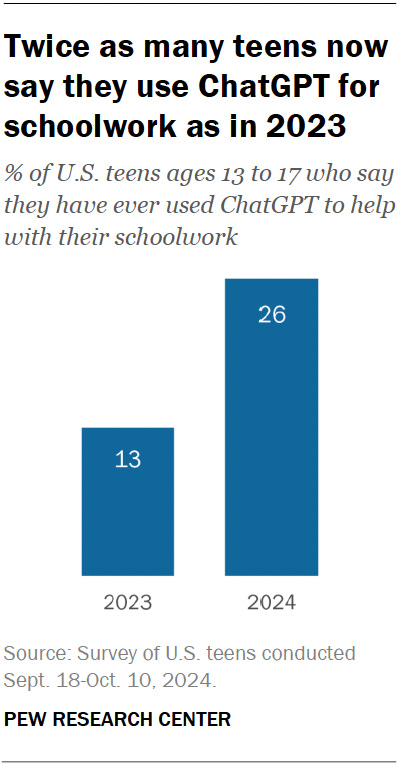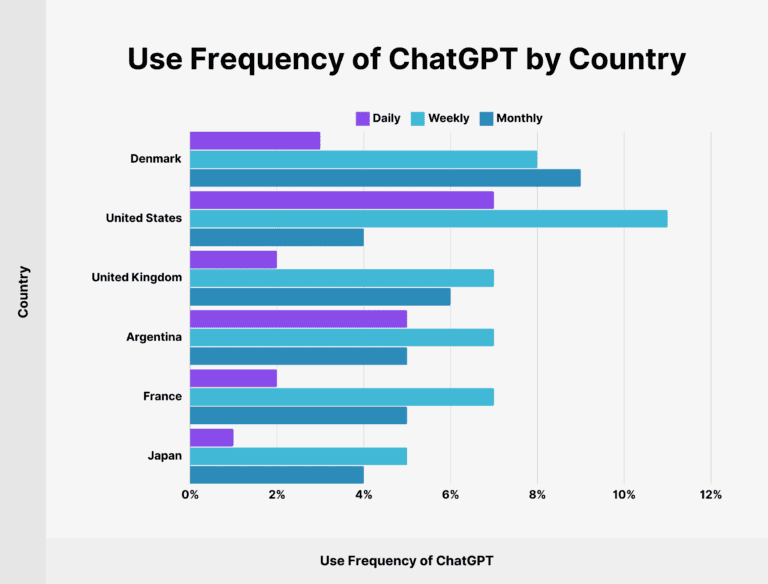ChatGPT Trends and Statistics in 2025
Numbers, Use Cases, and What ChatGPT Means for Your Next Search
A few years ago, ChatGPT was a viral novelty.
Now it’s quietly becoming a workplace staple. We’re seeing it shift from curiosity to utility—embedded in tools, woven into workflows, and changing how people write, research, and make decisions.
This isn’t a story about AI potential. It’s what we’re seeing right now.
Let’s break it down.
ChatGPT by the Numbers
ChatGPT fields over a billion prompts a day. Usage has skyrocketed since 2023, notably after OpenAI introduced voice, image, and custom GPT capabilities. These changes made it more than a chatbot. They made it feel like an assistant.
Here’s what that growth actually looks like:
ChatGPT doubled its weekly active users in 6 months
Embedded across 160+ countries
Heaviest use in North America and Europe, with Asia and South America rising fast
Source: Similarweb data via a16z
It’s not just individuals using it. Entire teams and enterprises are incorporating it into their work processes.
In fact, I find myself using ChatGPT almost daily for research and ideation.
My team? They also find themselves using it daily in different capacities, both professionally and personally.
Who’s Using It, and How
If your work involves content, communication, or research, there’s a good chance ChatGPT is already part of your workflow.
Marketers use it to draft campaigns and social copy.
Teachers lean on it for lesson prep and quick answers.
Developers debug code and explain logic in plain English.
Doctors and admins rely on it to write notes and referrals.
Even finance, legal, and real estate teams are finding ways to integrate it.
At JS Interactive, our team uses ChatGPT in both personal and professional ways.
At work, we refine copy, build personas, analyze research, or turn transcripts into post-ready content.
It’s part of how we move ideas forward; faster, sharper, and with less friction.
The more people use it, the more second nature it becomes. ChatGPT is not a replacement, but a multiplier.
The Enterprise Shift
Big companies aren’t experimenting anymore. They’re operationalizing.
ChatGPT is now embedded in Slack threads, CRMs, internal wikis, and daily meetings. It’s showing up where real work happens, not just in side projects.
Some teams report a 66% jump in efficiency after integrating it into their workflows.
They’re using it to:
Draft meeting notes
Summarize customer calls
Generate internal documentation
Answer quick questions without opening five browser tabs
And it’s not just about saving time. It’s about cutting noise and improving clarity, especially for non-technical users who just want straight answers, fast.
This isn’t automation for the sake of it. It’s better communication across the board.
Education
In schools, ChatGPT is turning into a study buddy that never sleeps.
Students use it for feedback, summaries, and practice, especially in writing-heavy classes.
Teachers use it to generate lesson materials, clarify tough topics, and save hours on prep.
Some districts are already reporting higher grades thanks to more personalized, real-time help.
The key takeaway: it’s not doing the thinking for students. It’s helping them work through it.
Search Is Changing and Fast
More people are bypassing traditional search engines and opting for ChatGPT directly. You ask a full question, and you get a full answer. No popups. No clickbait.
That shift is already impacting SEO and how content gets found:
Google’s AI overviews are reducing organic clicks by more than 30%
Zero-click search now accounts for nearly 65% of all Google searches
Brands are adjusting their writing to be clear, accurate, and quotable.
If you’re creating content today, you’re not just writing for people on Google. You’re writing for the tools they’re using to skip the search altogether.
Behavioral Trends We’re Watching
Usage is growing, but how people interact with ChatGPT tells the bigger story. Here’s what we’re seeing:
Only about 7% of Americans use ChatGPT daily, although this varies by age and profession.
Power users treat it like a second brain, using it to draft, organize, and rewrite.
Users are asking longer, more complex questions, with the average prompt being 23 words, compared to 4.2 for a typical search.
Source: Backlinko
That shift reflects growing trust. The more helpful it becomes, the more people rely on it across roles and teams.
And it’s not just tech or marketing. It’s everyone.
What This Means for Teams
If you lead a team, this isn’t about “adding AI.” It’s about removing friction.
The teams seeing the most value aren’t using ChatGPT to replace people. They’re using it to clear bottlenecks, speed up decision-making, and shift focus from mundane tasks to meaningful work.
Here’s how we typically use it across the team for a single piece of content:
Start with ideation: Generate angles, headlines, or structures based on a goal or topic.
Move into research: Use it to explore questions, find gaps, and summarize relevant insights.
Draft quickly: Build a rough version more quickly, especially when working on long-form content or starting from scratch.
Edit collaboratively: Tighten language, clarify ideas, and rework weak spots.
Refine the final version: Polish for tone, flow, and accuracy.
Repurpose with intention: Turn the finished piece into social posts, video scripts, newsletter blurbs, or outlines for future content.
At every step, we’re humanizing the content by adding our voice, personal experience, and intent that AI can’t replicate.
The result? Content that moves faster, reads better, and helps the team stay focused without burning out.
Where This Is All Headed
ChatGPT isn’t a trend. It’s infrastructure. Quietly, it’s becoming an integral part of how modern teams write, think, and communicate—whether that’s in content strategy, customer support, or daily operations.
The tools will keep evolving. The prompts will get sharper. But the teams that win won’t just use AI. They will build it into their process without losing their voice.
This isn’t about doing more with less. It’s about doing better with what you already know.
If you’re not figuring out how to use it well, you’re already behind.





